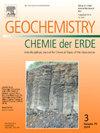Quartz textures, mineral chemistry and fluid inclusion features of Tuztaşı low-sulphidation Au mineralization: Implication to it's formation
IF 2.9
3区 地球科学
Q2 GEOCHEMISTRY & GEOPHYSICS
引用次数: 0
Abstract
The Tuztaşı gold mineralization, within the Main Quartz Vein (MQV), is located within the amphibolite schist of the Sütüven Formation along a structural zone trending K50D. The vein is inclined approximately 40° to the northeast, exhibits a thickness ranging from 3 to 8 m with 2 km lenght. Gangue minerals within the vein primarily consist of quartz, chalcedony, and opal. In MQV, crustiform, feathery, colloform textures indicating boiling and massive chalcedony, comb, textures in restricted zones, as well as replacement textures and brecciation in later stages have been identified.
In the amphibolite, the host rock around the MQV, while weak argillic alteration developed represented by quartz, montmorillonite, kaolinite mineral associations, this alteration is surrounded by propylitic alteration represented by quartz, albite, orthoclase, chlorite, calcite, and ankerite mineral associations.
LA-ICP-MS studies on quartz of the MQV revealed the gold values up to 4.02 ppm and silver values reaching 100 ppm, predominantly enriched in secondary voids (vugs) and iron-rich fracture zones. SEM-EDX analyses of gold-bearing quartz have identified chromite, chalcopyrite, native platinum, and Ni-Fe-Cr alloy, suggesting interactions with ore-forming fluids potentially originating from the mafic-ultramafic levels of the Sütüven Formation and Çetmi Melange.
Fluid inclusion studies show that liquid-rich inclusions dominate in MQV, but vapour-rich inclusions also occur together in genetically. According to microthermometric data, Th values of quartz vary between 186 and 330 °C, but the majority of the data (89 %) fall within the 180–260 °C range (aver. 213 °C, n = 104). The salinity of the fluids ranges from 0.18 % to 2.74 %, with an average of 0.63 % wt. NaCl equivalent. The dominant temperature range (180–260 °C) corresponds to a salinity of 0.35 wt% NaCl equivalent. An average Th (221 °C) and salinity (0.63 % wt. NaCl equivalent) values are resemble typical of low-sulphidation gold deposits.
Oxygen isotope (δ18O) data of quartz from the MQV, ranging between 6.6 ‰ and 8.6 ‰, indicating a meteoric origin for the fluids. This is indicated by the δ18OSMOW values of waters in equilibrium with quartz, falling between δ18Owater − 6.8 ‰ and 0.7 ‰.
Collevtively, fluid inclusions, oxygen isotope data, quartz textures in MQV and alteration features are evaluated together, the Tuztaşı Au mineralization exhibits the characteristics of a low-sulphidation type Au deposit rather than an orogenic type Au deposit.
tuzta低硫化金成矿的石英结构、矿物化学和流体包裹体特征及其形成意义
在主石英脉(MQV)内的tuzta 金矿,沿K50D走向的构造带位于s tt组角闪岩片岩中。脉体向东北倾斜约40°,厚度3 ~ 8 m,长度2 km。脉石矿物主要由石英、玉髓和蛋白石组成。在MQV中,发现了表明沸腾和块状玉髓的壳状、羽状、胶状织构,梳子状织构,限制带织构,以及后期的替代织构和角化。在角闪岩中,寄主岩石在MQV周围发育以石英、蒙脱石、高岭石矿物组合为代表的弱泥质蚀变,在此蚀变周围发育以石英、钠长石、正长石、绿泥石、方解石、铁白云石矿物组合为代表的丙质蚀变。对MQV石英进行LA-ICP-MS分析,金值高达4.02 ppm,银值高达100 ppm,主要富集于次级孔洞和富铁断裂带。含金石英的SEM-EDX分析发现了铬铁矿、黄铜矿、天然铂和Ni-Fe-Cr合金,表明其与成矿流体的相互作用可能来自于s tt组和Çetmi混杂岩的基性-超基性水平。流体包裹体研究表明,富液包裹体在MQV中占主导地位,但富气包裹体也在遗传上一起出现。根据显微测温数据,石英的Th值在186 - 330°C之间变化,但大多数数据(89%)在180-260°C范围内(平均值)。213°C, n = 104)。流体盐度范围为0.18% ~ 2.74%,平均为0.63% wt. NaCl当量。主导温度范围(180-260℃)对应的盐度为0.35 wt% NaCl当量。平均Th(221°C)和盐度(0.63% wt. NaCl当量)值与典型的低硫化金矿相似。石英的氧同位素(δ18O)数据在6.6‰~ 8.6‰之间,表明流体的成因为大气。石英平衡水的δ18OSMOW值介于δ18Owater - 6.8‰和0.7‰之间。综合评价流体包裹体、氧同位素、MQV石英结构及蚀变特征,认为tuzta金矿成矿特征为低硫化型金矿,而非造山型金矿。
本文章由计算机程序翻译,如有差异,请以英文原文为准。
求助全文
约1分钟内获得全文
求助全文
来源期刊

Chemie Der Erde-Geochemistry
地学-地球化学与地球物理
CiteScore
7.10
自引率
0.00%
发文量
40
审稿时长
3.0 months
期刊介绍:
GEOCHEMISTRY was founded as Chemie der Erde 1914 in Jena, and, hence, is one of the oldest journals for geochemistry-related topics.
GEOCHEMISTRY (formerly Chemie der Erde / Geochemistry) publishes original research papers, short communications, reviews of selected topics, and high-class invited review articles addressed at broad geosciences audience. Publications dealing with interdisciplinary questions are particularly welcome. Young scientists are especially encouraged to submit their work. Contributions will be published exclusively in English. The journal, through very personalized consultation and its worldwide distribution, offers entry into the world of international scientific communication, and promotes interdisciplinary discussion on chemical problems in a broad spectrum of geosciences.
The following topics are covered by the expertise of the members of the editorial board (see below):
-cosmochemistry, meteoritics-
igneous, metamorphic, and sedimentary petrology-
volcanology-
low & high temperature geochemistry-
experimental - theoretical - field related studies-
mineralogy - crystallography-
environmental geosciences-
archaeometry
 求助内容:
求助内容: 应助结果提醒方式:
应助结果提醒方式:


